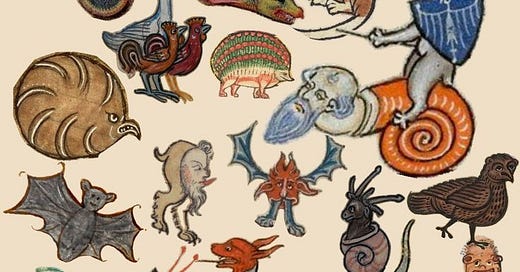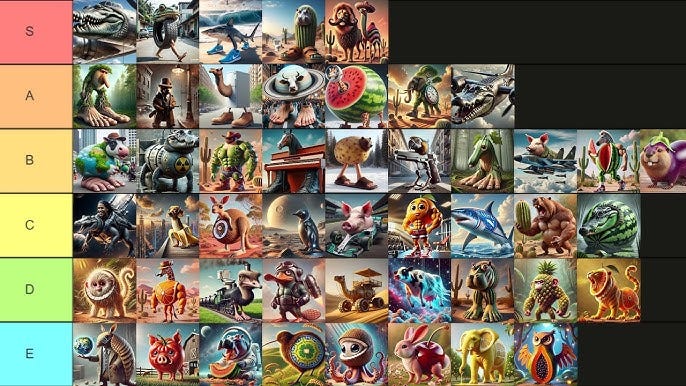Why Italian Brainrot Gives Me Hope For Humanity
On collective mythmaking after the end of meaning
The Italian brainrot side of TikTok has been dreaming up a bestiary of AI-generated characters. There’s Chimpanzini Bananini, a chimpanzee with a banana body; Tralalero Tralala, a three-legged, sneaker-wearing shark; La Vaca Saturno Saturnina, with a cow’s head, a body shaped like the planet Saturn, and a pair of giant human feet; Trippi Troppi, a cat-headed shrimp; and Lirili Larila, an elephant with cacti for legs.
The earliest known instance of the so-called Italian Brainrot Animals traces back to January 2025, when TikToker @amoamimandy posted an AI-generated image of a shark named Tralalero Tralala with three legs wearing blue Nike sneakers with a CapCut Flame Explosion filter over it, narrated by an Italian male AI-generated voice uttering, liltingly, a filthy nursery rhyme:
Tralalero Tralalà, pig-God and pig-Allah. I was with my fucking little shit son playing Fortnite, when at one point my grandmother, Ornella Cocklicker, comes in to warn us that that asshole Burger had invited us to dinner to eat a purée of dicks.
Soon, other users began—and still are—generating new characters that also went viral, all following the same format: an absurd, AI-generated hybrid creature backed by an AI-generated male voice chanting a nonsensical rhyme. There are too many to count, but some of the most notable include Bombardiro Crocodilo, a cross between a crocodile and a military bomber plane; Brr Brr Patapim, half-baboon, half-forest; and from Indonesia, Tung Tung Tung Sahur, an anthropomorphic stick holding a baseball bat. Legitimacy in the pantheon, a creature’s acceptance as canon, is determined by its memetic velocity, its ability to rise to the top of the feed.
Using a generally accepted cast of a couple dozen characters that have best managed to lodge themselves in the algorithmic unconscious, users also began creating new lore. This content often takes the form of “powerscaling,” which involves pitting one character against another in AI-generated video battle. Some videos show the aftermath of the fight, in which the creatures make up with a loving embrace. Other projects establish still deeper narratives, tracing the characters’ backstories and their relationships to one another. The Italian Brainrot Universe at times slips into the adjacent John Pork Universe, which follows the anthropomorphic AI-generated mouse and criminal mastermind Tim Cheese, who has allegedly murdered the virtual Instagram influencer John Pork, an anthropomorphic pig who has been posting online since 2018.
What’s happening here is the creation of an internet-native folklore, a collaborative mythmaking playing out over weeks and months rather than generations, generating an absurdist pantheon that roots itself in collective vibe rather than cultural memory.
On the internet, the mechanics of myth are different. Folklore unfurls far across networked space instead of deep through time, amassing wide reach but little staying power. But like traditional folklore, Italian brainrot is also passed along informally, orally, through repetition and variation. It’s collectively-authored and community-owned rather than attributed to a single point of origin.
The creation of all this elaborate mythos is enabled, in large part, by generative AI. This depth of worldbuilding would be impossible without it, since, for the first time, AI gives users the ability to create entirely new characters and stories, rather than just repurposing static memes for new contexts. The Italian Brainrot phenomenon could be an early signal that the next phase of memeing may be AI-enabled worldbuilding; by the time these brainrot beasts and their absurd incantations are inevitably buried under the next layer of digital sediment, artifacts of a bygone micro-era, it’s possible that they’ll be supplanted by entirely new, collaboratively-built meme-universes. If the internet turned myths into memes, now the pendulum is swinging back. Meme becomes myth again.
“Brain rot" was Oxford University’s 2024 Word of the Year, referring to “low-quality, low-value content content found on social media and the internet, and the subsequent negative impact that consuming this type of content is perceived to have on an individual or society.” Brainrot offers nothing and asks for nothing in return. It requires no interpretation. It’s certainly not trying to sell you anything. It’s pure abusrdity, pure silliness. And it’s this utter lack of meaning that actually makes brainrot…kind of radical.
Paradoxically, brainrot’s meaninglessness makes it an ideal medium for connection. Algorithmic culture is divisive, with platforms optimizing for engagement by feeding users increasingly narrow content based on past behavior, reinforcing existing beliefs and creating divergent, incompatible realities. Additionally, the feed-based design of social media encourages one-sided consumption of content, rather than creation and collaboration with networks of other people. Somehow, the Italian Brainrot animals have managed to transcend both of these design mechanisms, offering something both universal and collaborative. The Italian Brainrot Animals are beloved because they’re devoid of meaning, yet still find emotional resonance. They’re strange, silly, and, because they offer no ideology, commentary, or moral alignment, they’re universally accessible.
The Italian Brainrot folklore has quickly rooted into collective consciousness. TikTokers on the street ask passersby if they prefer Cappuccino Assasino or Lirili Larila? Tung Tung Tung Sahur or Bombardiro Crocodilo? Everyone has an answer. Other TikTokers make “tier list” videos ranking the characters. Some create aesthetic starter pack compilations for the Cocofanto Elefanto or the Trippi Troppi Girl. Several people have already gotten tattoos. Commitment to this fandom is an act of meaninglessness, collectively and joyfully performed.
Like all folklore, Italian Brainrot reveals something about the people who create it. It’s reflective of a youth culture (it appears, mostly, to be created by teenagers) that finds amusement in nihilism, that feels the world no longer makes sense and relinquishes any desire to try, and that finds more value in humor and connection than in logical meaning. Brainrot’s meaninglessness, then, becomes the substrate for the emergence of a different kind of meaning.
Transgressing algorithmic boundaries, the Italian Brainrot Animals have sparked an unlikely moment of true international collaboration with the emergence of this open-source folklore. They offer the sense of standing, however briefly, on a common cultural ground. And it’s precisely their refusal to mean anything—their absence of morality or agenda—that lays the groundwork for a deeper kind of connection. That which resists interpretation resists division.






Can't wait to have you in the conversation for Federico Campagna's Prophetic Culture, where we'll discuss the role of The Grotesque in navigating transitions from one historical epoch and worlding mode to the next. https://michaelgarfield.substack.com/prophetic-culture
"Manmade horrors beyond our comprehension" or "Evil is the annunciation of the next level of order?" Either way, Michael Crichton was right about looking to genetic engineering x computer simulation as the nexus of what lies beyond scientific modernity.
I keep telling myself it's not too late to join TikTok...